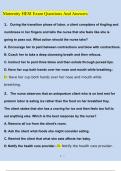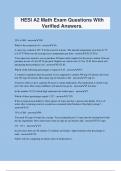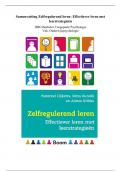Test Bank for A Topical Approach to Lifespan Development
11th Edition By John Santrock. All chapters 17 are included
, 1
Student:
1. Life-span development covers the period from to .
A. birth; middle adulthood
B. birth; old age
C. conception; early adulthood
D. conception; death
2. Which of the following gives the BEST description of how life-span psychologists
describe "development"?
A. growth and decline in skills and processes
B. growth and decline in skills and processes from birth to adolescence
C. growth in skills and processes
D. decline in skills and processes
3. Life-span development is the study of human development from conception to death. Historically,
however, most of the focus has been on which age group?
A. children and adolescents
B. young adults
C. middle-aged adults
D. the elderly
4. The upper boundary of the human lifespan is years.
A. 105
B. 117
C. 122
D. 131
5. Although the maximum life span of humans has not changed, during the twentieth century, life
expectancy
A. in the U.S. has increased by 15 years.
B. in the world has increased by 15 years.
C. in the U.S. has increased by 30 years.
D. in the world has increased by 30 years.
6. According to life-span development expert Paul Baltes, which age period dominates development?
A. infancy–childhood
B. adolescence–early adulthood
C. middle-aged to late adulthood
D. No single age group dominates development.
7. Diana feels that her human development course overemphasizes the changes that occur from birth to
adolescence and disregards the developmental issues of adulthood. Which developmental perspective
would address her concerns?
A. traditional
B. life-span
C. ethological
D. ecological
,8. Some professors want to teach about the life-span approach in a Human Development course, whereas
others want to keep the traditional developmental approach. They disagree about
A. the plasticity of development.
B. the multidimensional nature of development.
C. whether development is lifelong.
D. whether development is multidirectional.
9. Baltes describes development as multidirectional. What does this mean?
A. Development is not dominated by any single age period.
B. Development consists of biological, cognitive, and socioemotional dimensions.
C. Development is characterized by both growth and decline.
D Development needs psychologists, sociologists, biologists, and neuroscientists to work together in
. unlocking the mysteries of development.
10. Kathy believes that life-span development cannot be studied without considering biological, social, and
cognitive aspects. Kathy believes that development is
A. lifelong.
B. multidirectional.
C. multidimensional.
D. plastic.
11. Researchers increasingly study the development of adulthood. This implies that development is
A. lifelong.
B. multidisciplinary.
C. multidirectional.
D. contextual.
12. Which of the following is NOT one of Paul Baltes' eight characteristics of the life-span perspective on
development?
A. lifelong and multidirectional
B. multidimensional and plastic
C. contextual
D. unidirectional
13. Many older adults become wiser by calling on experiential knowledge, yet they perform poorly on
cognitive speed tests. This is an example of how development is
A. plastic.
B. contextual.
C. multidimensional.
D. multidirectional.
14. The capacity for acquiring second and third languages decreases after early childhood, whereas
experiential wisdom increases with age. This is an example of how development is
A. lifelong.
B. multidisciplinary.
C. multidirectional.
D. contextual.
15. Which of the following is an example of how development is contextual?
A. Reasoning ability is biologically finite and cannot be improved through retraining.
B. Parents in the United States are more likely to rear their children to be independent than parents in
Japan.
C. Older adults call on experience to guide their decision making.
D. Intelligence may be studied by looking at genetics, anthropology, sociology, and other disciplines.
,16. In the United States, most individuals begin school around age 5, whereas in Australia they start at 3. This
is an illustration of how development is
A. lifelong.
B. multidisciplinary.
C. multidirectional.
D. contextual.
17. Normative age-graded influences, normative history-graded influences, and nonnormative life events are
all ways in which development can be classified as
A. multidirectional.
B. multidimensional.
C. contextual.
D. plastic.
18. Anna attributes her thriftiness to having been raised during the Great Depression. This is an example of a
A. nonnormative life event.
B. normative history-graded influence.
C. normative age-graded influence.
D. nonnormative age-graded influence.
19. The fact that I use e-mail virtually every day and my mother has never sent or received an e-mail is an
example of a difference in
A. normative history-graded influences.
B. nonnormative life events.
C. normative age-graded influences.
D. nonnormative age-graded influence.
20. Biological processes such as puberty and menopause are
A. nonnormative life events.
B. normative age-graded influences.
C. normative history-graded influences.
D. normative contextual influences.
21. Neleh was on a popular reality TV show and got widespread exposure. This is an example of a
A. nonnormative life event.
B. normative age-graded influence.
C. normative history-graded influence.
D. normative contextual influence.
22. Lauro is 83 years old. Much of his development will now focus on
A. growth and maintenance.
B. maintenance and regulation of loss.
C. regulation of loss.
D. growth and regulation of loss.
23. Contemporary concerns in life-span development perspective include
A. health and well-being issues.
B. parenting and education issues.
C. sociocultural, ethnicity, gender, and policy issues.
D. All of these answers are correct.
24. Of special consideration for social policy intervention are children who grow up
A. in poverty.
B. in single-parent homes.
C. addicted to heroin.
D. as part of a minority group.
,25. Children living in poverty are more likely to
A. be separated from a parent.
B. be exposed to violence.
C. be exposed to family turmoil.
D. be in all these situations.
26. The U.S. percentage of children living in poverty is
A. only half as much as some other industrialized nations.
B. more than twice as much as that in Canada.
C. lowest among the industrial countries.
D. not high enough to draw people’s concerns.
27. A primary concern in relation to social policy for older adults is the
A. increasing numbers who live in poverty.
B. increase in elder abuse.
C. failure of the health care system to address their needs.
D. need for funding public pensions.
28. At age 3, Jillian is beginning to engage her imagination. This is the process of Jillian's life-span
development.
A. ecological
B. biological
C. socioemotional
D. cognitive
29. Diego feels a strong happiness that he never had before as he holds his newborn child. This signifies
development in the process.
A. neurological
B. biological
C. socioemotional
D. cognitive
30. Doctors measure and chart a baby's height, weight, and head growth at each medical checkup. What
processes are being tracked?
A. abstract
B. biological
C. socioemotional
D. cognitive
31. Which of the following statements BEST describes the relationship between biological, cognitive, and
socioemotional development?
A. These processes develop independently of one another.
B. The development of these processes is intricately interwoven.
C. Social development is independent of biological and cognitive development.
D. Cognitive development sets the upper limits for biological and social development.
32. The developmental period during which a being grows from a single cell to an organism complete with
brain and behavioral capabilities in 9 months is called
A. prenatal.
B. infancy.
C. early childhood.
D. middle childhood.
33. Children in preschool years become more self-sufficient and can care for themselves. What period of
development are they in?
A. prenatal
B. infancy
C. early childhood
D. middle/late childhood
,34. Alec is almost completely dependent on his parents and is beginning to develop his language and
sensorimotor coordination. What period of development is he most likely in?
A. prenatal
B. infancy
C. early childhood
D. middle/late childhood
35. The period of early childhood ends when the child
A. is toilet trained.
B. learns to dress herself.
C. starts first grade.
D. has mastered reading, writing, and arithmetic.
36. Jen has mastered the fundamental skills of how to read and write. What period of development is she
most likely in?
A. middle childhood
B. late childhood
C. adolescence
D. primary years
37. Most traditional college students are considered to be in what developmental period?
A. late childhood
B. emerging adulthood
C. early adulthood
D. middle adulthood
38. Paulo is struggling to juggle school, work, and relationships while he is beginning to become more
independent and responsible. What period of development is he most likely in?
A. late childhood
B. adolescence
C. early adulthood
D. middle adulthood
39. Len feels greatly contented in his career. He has more time to spend with his family, contribute to
community activities, and mentor young people. What period of development is he most likely in?
A. late adulthood
B. middle adulthood
C. early adulthood
D. stability and regulation
40. Margaret spends a lot of time thinking about the choices she has made in her life and the events she has
witnessed. However, she needs to pay more attention to her health condition. Margaret is most likely in
A. late adolescence.
B. early adulthood.
C. middle adulthood.
D. late adulthood.
41. At what age do most people claim to be happiest in the U.S.?
A. 19 years
B. 25 years
C. 42 years
D. 88 years
42. At what age do people enter the "oldest old" age group?
A. 50 years
B. 65 years
C. 75 years
D. 85 years
,43. What developmental period is marked by sizeable losses in cognitive potential, chronic stress, and frailty?
A. oldest old
B. young old
C. late adulthood
D. middle adulthood
44. Each fall, the choir teacher faces the task of retraining the deepening voices of some of his male students.
What period of development are these students most likely in?
A. middle childhood
B. adolescence
C. young adulthood
D. late childhood
45. Leo is 65 years old. He is coping well with his change of lifestyle and is highly motivated to learn new
things. Leo is young in his age.
A. social
B. biological
C. chronological
D. psychological
46. Which of the following is NOT a commonly conceptualized way of viewing age?
A. biological age
B. cognitive age
C. social age
D. psychological age
47. Becoming a grandmother is an example of age.
A. biological
B. cognitive
C. social
D. psychological
48. Mrs. B is a 66-year-old. She dreads retirement, saying that she has no hobbies and no ideas about how she
will structure her new abundance of time. She is experiencing difficulty with her age.
A. biological
B. social
C. chronological
D. psychological
49. The functional capacities of a person's vital organ system indicate age.
A. chronological
B. biological
C. psychological
D. social
50. Jerry is 60 years old and is training for his first marathon. He has strong muscles and is in perfect health.
Jerry is relatively young in his age.
A. chronological
B. biological
C. psychological
D. social
51. A person's adaptive capacities compared with those of other individuals of the same chronological age are
called age.
A. psychological
B. social
C. biological
D. coping
,52. Brent has a son diagnosed with ADHD and believes that this is primarily due to genetics, given that his
father had ADHD as well. Brent most likely believes that ADHD is primarily influenced by
A. nature.
B. nurture.
C. stability.
D. continuity.
53. In the nature/nurture debate, one's is related to "nature," while one's is related to "nurture."
A. biological inheritance; environment
B. age; environment
C. biological inheritance; behavior
D. environment; biological inheritance
54. During her intake interview, Jody's psychiatrist asks for a familial history of mental disorders, as well
as for details about her childhood friends, neighborhood, and schools. The psychiatrist is gathering
information related to the influence of on development.
A. biology and environment
B. biology
C. environment
D. cognitive acuity and coping skills
55. Although Angie was somewhat irresponsible as a teen, she changed her ways when she entered college
and leased her first apartment. This example relates to the developmental issue of
A. stability and nature.
B. stability and change.
C. continuity and discontinuity.
D. nature and nurture.
56. In the final analysis, most developmentalists tend to believe that
A. development is more continuous than discontinuous.
B. for the most part, people can't change.
C. nature is more important than nurture.
D development is influenced by nature and nurture, and is characterized by continuity and discontinuity,
. and also by stability and change.
57. The life-span development concept of plasticity aligns most closely with which of the following?
A. stability
B. change
C. nature
D. nurture
58. Reactive Attachment Disorder is thought to be a lifelong condition caused by a lack of nurturing care
during the early years of life. This diagnosis aligns with the developmental issue of
A. stability.
B. change.
C. nature.
D. discontinuity.
59. Tammy was shy as a child but became more outgoing and confident when she attended a university far
from her hometown. This is an example of which developmental issue?
A. multidirectionality
B. multidimensionality
C. nature and nurture
D. stability and change
,60. The controversy of stability versus change is closely linked to which of the following concepts?
A. plasticity.
B. contextualism.
C. multidimensionalism.
D. multidirectionality.
61. Conceptualize a problem to be studied, collect data, analyze data, and draw conclusions. These steps
describe
A. discontinuity in development.
B. the scientific method.
C. a hypothesis.
D. a theory.
62. Nala decides to explore teenage pregnancy prevention for her Master's thesis. According to the scientific
method, what should be her first step in getting started?
A. Analyze the information she has gathered.
B. Draw conclusions from the collected data.
C. Conceptualize the problem to be studied.
D. Begin to collect information.
63. Which of the following statements is NOT true of a theory?
A. A theory is an interrelated, coherent set of ideas that helps explain phenomena.
B. A theory is an interrelated, coherent set of ideas that helps make predictions.
C. When studying a topic, it is advisable to choose one developmental theory and disregard all others.
D. A theory is an interrelated, coherent set of ideas that suggests hypotheses.
64. Psychoanalytic theories hold that development primarily depends on
A. the unconscious mind.
B. thinking, reasoning, language, and other cognitive processes.
C. behavior's link to environment.
D. biology and evolution.
65. Psychoanalytic theories stress what in development?
A. the child’s cognitive creativity
B. genes inherited from parents
C. late experiences with parents
D. early experiences with parents
66. Ben has repressed his sexual urges and has started to develop social and intellectual skills. Ben is in the
psychosexual stage called the stage.
A. phallic
B. anal
C. latency
D. oral
67. Erikson's theory emphasizes which of the following aspects of human development?
A. experiences in early life
B. psychosexual
C. experiences in late life
D. psychosocial
68. Each stage in Erikson's theory presents a crisis that must be resolved. These crises are
A. developmental landmarks with increased vulnerability.
B. developmental landmarks with both increased vulnerability and enhanced potentials.
C. catastrophic events that toughen the individual for future crises.
D. developmental landmarks with enhanced potentials.
, 69. According to Erikson, a preschooler is in the stage.
A. trust versus mistrust
B. initiative versus guilt
C. industry versus inferiority
D. identity versus identity confusion
70. At the airport, 4-year-old Kelly’s mom encourages her to help with dragging the bags off the luggage
carousel. According to Erikson's stage theory, Kelly's mom is helping Kelly develop
A. trust.
B. her identity.
C. initiative.
D. altruism.
71. The successful outcome of Erikson's stage of results in a healthy sense of independence.
A. autonomy versus shame and doubt
B. initiative versus guilt
C. industry versus inferiority
D. identity versus identity confusion
72. Piaget theorized that children move through distinct stages of cognitive development, with each stage
being qualitatively different from the one preceding. His theory reflects which aspect of developmental
philosophy?
A. discontinuity
B. multidirectionality
C. stability
D. nature
73. If you believe that development occurs in stages, and you focus on cognitive development in an attempt
to explain how children actively construct their own view of the world, then your personal theory is most
similar to that of
A. Vygotsky.
B. Piaget.
C. Erikson.
D. Freud.
74. While maintaining that children actively construct their knowledge, Vygotsky focused on in
explaining child cognitive development.
A. social interaction.
B. concrete operations.
C. formal operations.
D. organization and adaptation.
75. Carlos is just starting to learn about the world. According to Vygotsky’s sociocultural cognitive theory,
what is the most important tool he will use to do this?
A. mobility
B. sensory perceptions
C. language
D. information-processing
76. Who among the following is a cognitive theorist?
A. Vygotsky
B. Freud
C. Erikson
D. Both Freud and Erikson were cognitive theorists.





